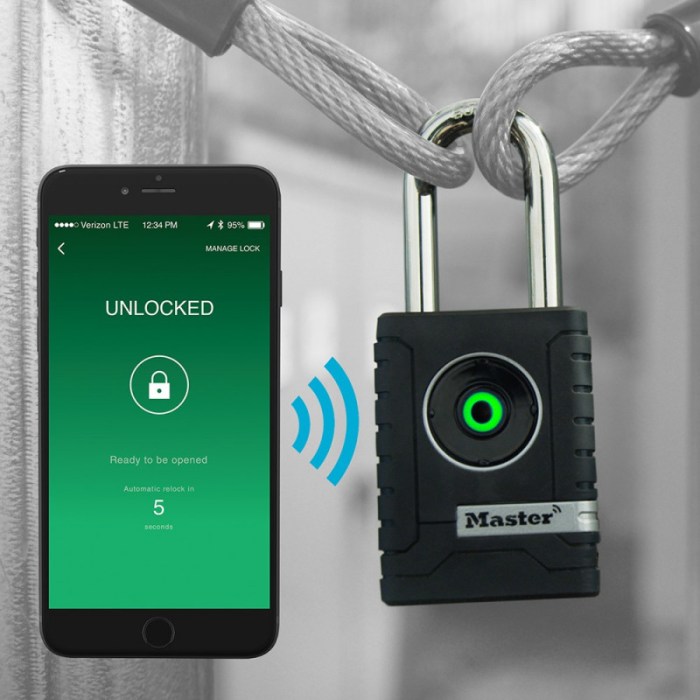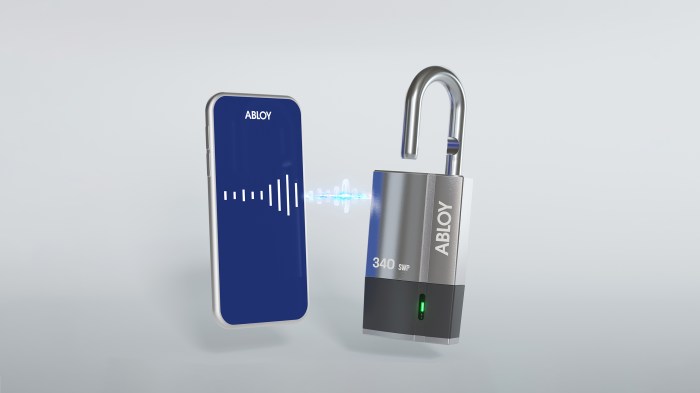Security and Privacy
Unlocking a padlock using Bluetooth technology offers convenience but also raises concerns about security and privacy. While it eliminates the need for physical keys, it introduces new vulnerabilities that can be exploited by malicious actors.
Bluetooth Communication Vulnerabilities
Bluetooth communication, while convenient, is inherently less secure than traditional key-based methods. Bluetooth signals can be intercepted and manipulated, allowing unauthorized individuals to gain access to the lock. This vulnerability arises from the open nature of Bluetooth communication, where data is transmitted over the airwaves without encryption by default.
Comparison with Traditional Key-Based Methods
Traditional key-based locks are generally considered more secure than Bluetooth-enabled locks. This is because physical keys are difficult to duplicate without authorization, and they cannot be intercepted or manipulated remotely. However, traditional locks are susceptible to physical attacks, such as picking or drilling, while Bluetooth locks offer a layer of protection against these attacks.
Examples of Potential Security Breaches
Several real-world examples demonstrate the security risks associated with Bluetooth-enabled locks. For instance, in 2019, researchers successfully hacked a popular smart lock using a Bluetooth exploit, allowing them to unlock it remotely. Similarly, in 2020, a vulnerability was discovered in a Bluetooth-enabled door lock, enabling unauthorized access through a brute-force attack. These examples highlight the importance of robust security measures and regular updates to mitigate potential vulnerabilities.
Functionality and User Experience
Unlocking a padlock with Bluetooth offers a seamless and convenient experience, revolutionizing traditional methods. The process involves pairing your smartphone or other Bluetooth-enabled device with the padlock, granting you the ability to unlock it remotely.
Pairing Process
Pairing a device with a Bluetooth padlock is a straightforward process. Typically, you need to activate Bluetooth on your device and locate the padlock in the list of available devices. The padlock will often have a unique pairing code or prompt you to enter a PIN. Once paired, the padlock will be registered to your device, allowing you to unlock it remotely.
Advantages and Disadvantages
Bluetooth unlocking presents several advantages over traditional methods, including:
- Convenience: Bluetooth unlocking eliminates the need for physical keys, allowing you to access your belongings from a distance. You can unlock your padlock without fumbling for keys or worrying about losing them.
- Remote Access: You can unlock your padlock from anywhere within Bluetooth range, making it ideal for situations where you need to access your belongings remotely.
- Security: Bluetooth unlocking can enhance security by limiting access to authorized devices. You can set up multiple user profiles and grant access to specific individuals.
However, there are also potential disadvantages to consider:
- Limited Range: Bluetooth has a limited range, typically around 30 feet. You will need to be within range of the padlock to unlock it.
- Battery Life: Bluetooth padlocks require a battery, which can be a concern if you frequently use the padlock or forget to recharge it.
- Security Concerns: While Bluetooth unlocking can enhance security, there is always a risk of unauthorized access if your device is compromised or if the Bluetooth connection is intercepted.
Scenarios for Bluetooth Unlocking
Bluetooth unlocking can be beneficial in various scenarios, such as:
- Home Security: You can use a Bluetooth padlock to secure your doors, gates, or other valuables, granting access to family members or trusted individuals.
- Storage Units: Bluetooth unlocking provides a convenient way to access your storage unit without needing to carry a key. You can also grant access to movers or other individuals who need to access your unit.
- Travel: Bluetooth padlocks are ideal for securing luggage or backpacks during travel. You can easily unlock your belongings at your destination without worrying about lost keys.
Technology and Implementation
Unlocking padlocks with Bluetooth utilizes a combination of hardware and software components that enable communication and authentication. The process involves establishing a secure connection between the padlock and a smartphone or other Bluetooth-enabled device, allowing the user to unlock the padlock remotely.
Bluetooth Technology, The teo padlock can be unlocked using bluetooth
Bluetooth technology is a wireless communication standard that enables short-range data exchange between devices. It operates in the 2.4 GHz frequency band and uses low-power radio waves to transmit data. Bluetooth utilizes a variety of protocols to ensure secure and reliable communication, including:
- Bluetooth Low Energy (BLE): This protocol is specifically designed for low-power applications, making it ideal for battery-powered devices like padlocks. It allows for long battery life while maintaining a reliable connection.
- Secure Simple Pairing (SSP): This protocol provides a secure method for pairing Bluetooth devices, ensuring that only authorized devices can connect to the padlock. SSP uses a combination of passkeys and confirmation prompts to verify the pairing process.
- Advanced Encryption Standard (AES): This encryption algorithm is used to secure data transmission between the padlock and the smartphone, protecting the communication from unauthorized access.
Hardware Components
The hardware components involved in Bluetooth padlock unlocking include:
- Bluetooth Module: This module is integrated into the padlock and handles Bluetooth communication. It receives and transmits data to the smartphone, enabling unlocking commands.
- Microcontroller: This component processes commands from the Bluetooth module and controls the padlock’s unlocking mechanism. It may also handle other functions, such as battery monitoring and security features.
- Unlocking Mechanism: This is the physical part of the padlock that is activated to unlock the lock. It can be a traditional locking mechanism with a Bluetooth-controlled release mechanism or a more advanced system using electric actuators.
Software Components
The software components involved in Bluetooth padlock unlocking include:
- Smartphone App: This app is installed on the user’s smartphone and provides a user interface for interacting with the padlock. It allows users to connect to the padlock, send unlocking commands, and manage security settings.
- Firmware: This software runs on the padlock’s microcontroller and manages the Bluetooth communication, unlocking mechanism, and other padlock functions.
- Cloud Services (Optional): Some Bluetooth padlocks may use cloud services to store user data, manage access permissions, and provide additional features like location tracking or remote control.
Unlocking Process
The Bluetooth unlocking process involves the following steps:
- Pairing: The user pairs their smartphone with the padlock using the Bluetooth app. This process typically involves entering a PIN code or confirming a pairing request on both devices.
- Authentication: Once paired, the smartphone app authenticates the user’s identity using a password, fingerprint scan, or other security methods. This ensures that only authorized users can unlock the padlock.
- Unlock Command: The user sends an unlocking command to the padlock through the Bluetooth app. This command is encrypted and transmitted securely to the padlock.
- Padlock Response: The padlock receives the unlocking command and verifies its authenticity. If the command is valid, the padlock unlocks the mechanism, allowing the user to open the lock.
Applications and Use Cases
Bluetooth-enabled padlocks offer a wide range of applications across various industries, revolutionizing security and access control. These locks leverage the convenience and accessibility of Bluetooth technology to provide a seamless and secure user experience.
Home Security
Bluetooth-enabled padlocks are ideal for enhancing home security. They eliminate the need for traditional keys, offering a keyless entry system. Homeowners can grant temporary access to guests, service personnel, or family members without physically handing over keys. The Bluetooth connection enables remote locking and unlocking, allowing users to check the status of their doors from anywhere. Additionally, the ability to track access history provides valuable insights into who has accessed the property and when.
Businesses
In businesses, Bluetooth padlocks offer numerous advantages. They streamline access control for employees, contractors, and visitors, eliminating the need for key management systems. The ability to assign specific access permissions to different individuals ensures that only authorized personnel can access specific areas. Businesses can also track access logs to monitor activity and identify potential security breaches. These locks are particularly beneficial in warehouses, storage facilities, and offices, where secure access control is paramount.
Storage Facilities
Storage facilities benefit greatly from Bluetooth padlocks. They provide a secure and convenient way to access storage units. Customers can access their units using their smartphones, eliminating the need to carry keys or remember combinations. The ability to remotely lock and unlock units enhances security and allows for easy access control. Storage facilities can also use Bluetooth locks to track access history, ensuring accountability and preventing unauthorized access.
Other Applications
Beyond these specific examples, Bluetooth padlocks find applications in various other industries, including:
- Healthcare: Secure storage of medical equipment and pharmaceuticals, with access control for authorized personnel.
- Education: Secure lockers for students and faculty, providing convenient access and reducing the risk of lost keys.
- Transportation: Secure storage compartments in vehicles, allowing for convenient and secure access to valuables.
Future Developments: The Teo Padlock Can Be Unlocked Using Bluetooth
The world of Bluetooth padlocks is constantly evolving, with new technologies and features emerging all the time. As the demand for smart home solutions grows, we can expect to see even more innovative and secure Bluetooth padlocks in the future.
Integration of New Features and Functionalities
The integration of new features and functionalities will enhance the user experience and expand the capabilities of Bluetooth padlocks.
- Voice control will allow users to unlock their padlocks with a simple voice command, eliminating the need to fumble with keys or smartphones. Imagine saying, “Alexa, unlock the shed door,” and having your padlock automatically open.
- Biometric authentication, such as fingerprint scanning or facial recognition, will provide an extra layer of security, making it even harder for unauthorized individuals to gain access. This technology is already being implemented in other smart home devices, and it’s only a matter of time before it becomes a standard feature in Bluetooth padlocks.
- Integration with smart home ecosystems will allow Bluetooth padlocks to seamlessly interact with other smart devices, such as home security systems, lighting, and thermostats. This will create a more connected and convenient living experience.
- Advanced encryption algorithms will ensure that the data transmitted between the padlock and the user’s device is secure, protecting against unauthorized access and data breaches.
- Remote access and management features will allow users to control their padlocks from anywhere in the world, providing peace of mind and convenience.
Vision for the Future of Bluetooth-Enabled Locks
The future of Bluetooth-enabled locks is bright, with the potential to revolutionize how we secure our homes and belongings.
- We can envision a future where Bluetooth padlocks are integrated into all aspects of our lives, from our homes and offices to our cars and luggage.
- These locks will be more secure, more convenient, and more user-friendly than ever before, providing us with a greater sense of safety and peace of mind.
- As technology advances, we can expect to see even more innovative features and functionalities emerge, making Bluetooth padlocks an essential part of the smart home of the future.
The teo padlock can be unlocked using bluetooth – The Teo Padlock, with its Bluetooth unlocking capabilities, represents a significant leap forward in the world of access control. While it offers undeniable convenience and a user-friendly experience, the potential security risks associated with Bluetooth technology cannot be ignored. As technology continues to evolve, it’s crucial to find a balance between innovation and security, ensuring that our digital keys are as secure as the physical ones they replace.
Imagine this: you’re rushing home, hands full of groceries, and you can’t find your keys. But no worries, your Teo padlock can be unlocked using Bluetooth! And with pew research showing that 64% of Americans now own a smartphone , it’s safe to say this tech is becoming pretty mainstream. So ditch the key-fumbling days, and embrace the future of convenient, Bluetooth-powered security.
 Standi Techno News
Standi Techno News

